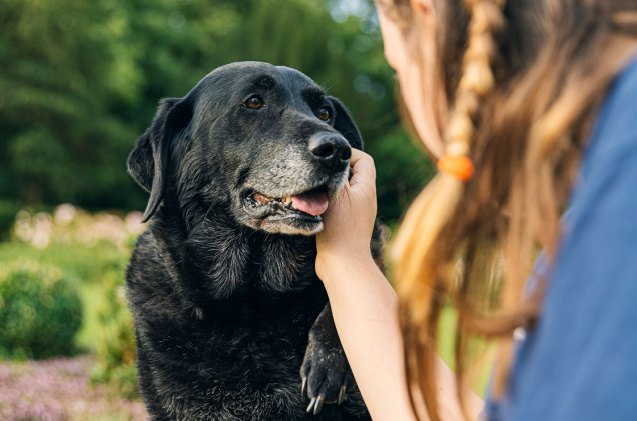What Is Better for Dog Arthritis, Heat or Cold?

Dog arthritis is a common condition that affects many senior canines, causing pain, stiffness, and reduced mobility. Even though it is hard seeing your pet’s discomfort, there are various ways to alleviate your furry friend's discomfort without using drugs. One of these natural methods of pain relief for dog arthritis is applying heat or cold to their joints. But which is better for dog arthritis, heat or cold – and when should you use them? Read on to find out more and learn how to help your four-legged bestie feel better in their golden years.
What Are The Symptoms Of Arthritis In Dogs?
Symptoms of arthritis in dogs can vary depending on the severity of the condition and which of the joints are affected. It is important that you can recognize them before they become too severe. Here are some common signs to look out for:
- Limping or favoring certain limbs: Dogs with arthritis often experience pain and stiffness in their joints, leading them to avoid using the affected limb.
- Stiffness and decreased mobility: Arthritic dogs may exhibit stiffness, especially after rest or in the morning. They may have difficulty moving around, climbing stairs, or jumping onto furniture.
- Lameness: Lameness refers to an abnormal gait or walking pattern. Dogs with arthritis may develop an uneven or altered gait, favoring certain limbs to minimize discomfort.
- Swelling and joint deformities: In some cases, arthritic joints may become swollen, tender, or warm to the touch.
- Behavioral changes: Chronic pain from arthritis can cause behavioral changes in dogs. They may become more irritable, restless, or withdrawn.
- Muscle atrophy: Due to reduced mobility and limited use of affected limbs, dogs with arthritis may experience muscle wasting or atrophy in the surrounding muscles.
- Licking or biting at joints: Dogs may lick, bite, or chew at the joints affected by arthritis in an attempt to alleviate the discomfort.
- Reluctance to exercise or engage in physical activities: Dogs with arthritis may exhibit a decreased interest in activities they once enjoyed.
It's important to note that these symptoms can also be indicative of other medical conditions, so it is crucial to consult with a veterinarian for an accurate diagnosis.
When Should You Use Heat Therapy for Dog Arthritis?
Heat therapy involves the application of warmth to affected areas, aiming to increase blood flow, relax muscles, and relieve pain. Of course, there are some specific situations in which you should opt for the heat treatment. For example, during cold weather which can worsen the symptoms of arthritis; before exercise or physical activity, in order to increase blood flow; prior to massage or physical therapy as relaxation; or after physical exertion as a soothing method.
Classic heating pads such as this practical warming mat from Riogoo can be a great helping hand in these situations. It’s great because it comes in different sizes so it will be a good fit for any dog, small or large breed, and the temperature can be finely tuned to suit your pet’s needs.
If used properly, heat therapy can really make a difference in your pet’s mood and comfort level, and this heating pad is a great way for your pet to reap those benefits.
When Should You Use Cold Therapy for Dog Arthritis?
Cold therapy – commonly known as cryotherapy – relieves arthritis pain in a completely different way than heat does, so it is used in different situations. It is particularly useful when your pet suffers from acute inflammation or injury as the coolness will soothe the affected area. You should also use it during arthritis flare-ups when pain is high to reduce swelling and inflammation, or during recovery from surgery.
To help your pet get through a flare-up or recover after a procedure with cryotherapy, you can use cold packs and compression wraps, such as this one from Labra. We love it because it is versatile (it has both hot and cold packs) and easy to use, as it has flexible Velcro straps so putting it on your pet’s joints is a breeze. It certainly beats trying to use ice wrapped in a towel on your squirming pooch!
What Else Can You Do to Help Manage Your Dog's Joint Pain?
No one likes seeing their pet in pain and discomfort. It is only natural that you’d want to help them sooner rather than later, but it’s important to consider what is the best treatment option for your pet before you settle on a course of action.
First and foremost, you should always consult with your veterinarian. They can provide guidance on medication, supplements, and therapies that can help manage joint pain. Your veterinarian may also prescribe nonsteroidal anti-inflammatory drugs (NSAIDs) or other pain medications to help alleviate your dog's joint pain.
Weight management can also help as a preventative measure. Maintaining a healthy weight is crucial for dogs with joint pain, as excess weight places additional strain on their joints.
Exercise and physical therapy are key components in treating arthritis in dogs. Low-impact exercises, such as walking or swimming, can help keep your dog's joints mobile and muscles strong without causing excessive stress.
Joint supplements can make a big difference in your pet’s pain levels and quality of life. Certain joint supplements containing glucosamine, chondroitin, omega-3 fatty acids, or other beneficial ingredients may help support joint health and reduce inflammation.
Remember, every dog is unique, and what works for one may not work for another. It's important to work closely with your veterinarian to develop a comprehensive and individualized approach to managing your dog's joint pain effectively.

A proud mama to seven dogs and ten cats, Angela spends her days writing for her fellow pet parents and pampering her furballs, all of whom are rescues. When she's not gushing over her adorable cats or playing with her dogs, she can be found curled up with a good fantasy book.
More by Angela Vuckovic

























